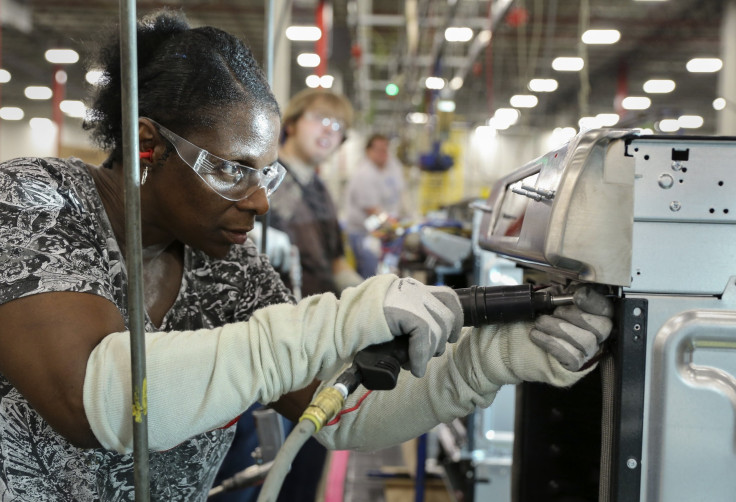March Jobs Report: Three Key Data Points To Watch For In Friday’s Employment Numbers

When the March jobs report arrives Friday morning, economists will scrutinize the data for indicators that might catch the eye of the Federal Reserve’s interest-rate-setting committee, which meets later in the month.
Given global economic weaknesses and dampened inflation expectations, few expect the Fed to move at its April meeting. But the jobs data released Friday could sway the Fed’s messaging, either helping to justify a projected two interest rate hikes this year or, in the case of a disappointment, make that path a vanishing possibility.
Analysts surveyed by Bloomberg expect 210,000 new jobs were added to nonfarm payrolls in March, a slight decline from the 242,000 added in February. Wage growth, meanwhile, is expected to come in at 0.2 percent from the previous month, a pickup from the surprise 0.1 percent drop in February.
Beyond those headline numbers, however, here are three data points to watch when the Bureau of Labor Statistics drops its latest batch of jobs figures Friday at 8:30 a.m. EDT.
1. The mystery of wage growth. Above all, the Fed wants higher inflation to justify further interest rate hikes. And a pickup in the price of goods and services depends in part on growth in workers’ wages. As unemployment falls, the theory goes, managers have to pay more to attract workers, pushing up the end prices charged to consumers. Though the relationship is far from perfect, the Fed’s projections rely largely on the pattern recurring.
The question is when. Even as unemployment more than halved after the height of the recession in 2010, wage growth has barely risen above a tepid 2 percent a year, well shy of average 3 percent year-over-year gains of the past 20 years.
Wage growth picked up suddenly in December and January, rising above 2.5 percent and giving economists hope a broader upsurge was coming. But those numbers slid back down in February.
“People started to uncork the champagne prematurely,” said Harry Holzer, professor of public policy at Georgetown University and author of the book “Where Are All The Good Jobs Going?” March’s data, Holzer said, could help show whether that rise was just a blip or part of a more sustained rise in worker pay.
Economists at Deutsche Bank aren’t optimistic. In a note this week they cited the recent National Federation of Independent Business survey data, which show just 12 percent of small business owners — who employ 42 percent of American workers — planning to hike wages. Taken together, economic data in the past month haven’t shown “any noticeable increase in wage pressures,” Deutsche Bank said.
2. Involuntary part-timers. Key to determining when the labor market is approaching its boiling point is ensuring that pockets of slack have evaporated. That slack includes ordinary unemployed workers as well as those who have given up in desperation and workers employed part-time who would rather work full-time.
The latter category, sometimes called involuntary part-time workers, has remained top-of-mind to Fed Chair Janet Yellen. In public comments earlier this week, Yellen told a group of economists the economy was “close” to full employment, citing elevated levels of involuntary part-timers as a lingering pool of slack in the market.
The share of those working part-time for economic reasons — as a share of the total working population — has fallen steadily since peaking in early 2010. But at 4.2 percent of working Americans, that total remains well above the 3 percent average in the 10 years before the recession.
Data like these are volatile on a month-to-month basis. But after stalling for the past four months, a drop in the share of involuntary part-time workers would prove a positive signal for the labor market.
3. Prime-age adults in the workforce. One metric that hasn’t tapered in recent months is the labor force participation rate, which measures the share of adults who are working or trying to work. After a nearly two-decade decline, exacerbated by the Great Recession, labor force participation has bumped up in recent months, an encouraging indication for the broader economy.
The pickup in the overall labor force participation rate has been especially encouraging given the surge in retirees from the outsize baby boomer generation. But the story is just as relevant in the so-called prime-age bracket of adults 25-54 years old.
Half of the decline in labor force participation during the recession was in prime-age workers giving up on employment, a trend that has taken years to put into reverse. In recent months, however, those workers are coming back. “Now that the labor market has been improving, people are more confident,” Holzer said.
One trend worth watching for: a sustained pickup in the number of prime-age adults in the workforce, measured as a share of the total population. “We’ve had some positive numbers on that for the past three to four months,” Holzer said. “We want to see if that continues.”
© Copyright IBTimes 2025. All rights reserved.






















